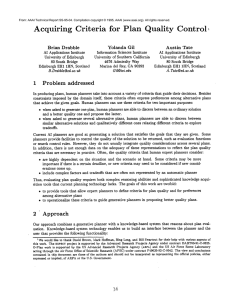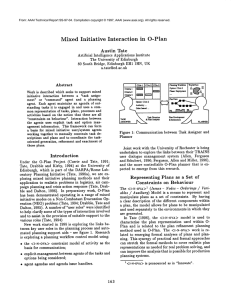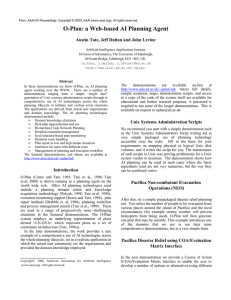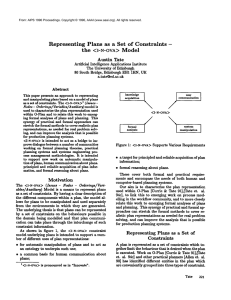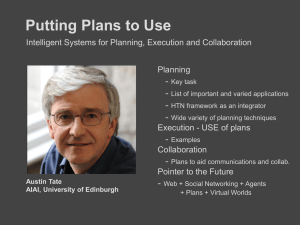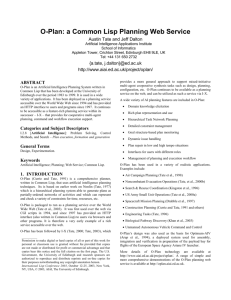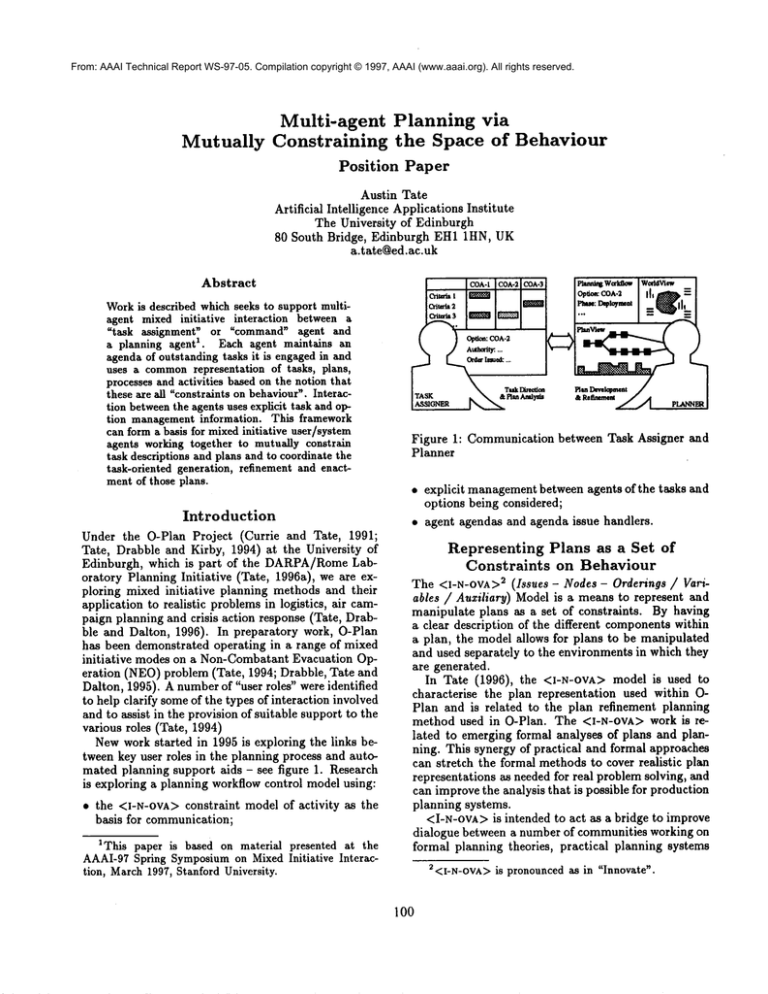
From: AAAI Technical Report WS-97-05. Compilation copyright © 1997, AAAI (www.aaai.org). All rights reserved.
Multi-agent
Mutually Constraining
Position
Planning via
the Space of Behaviour
Paper
Austin Tate
Artificial Intelligence ApplicationsInstitute
The University of Edinburgh
80 South Bridge, Edinburgh EH11HN, UK
a.tate~ed.ac.uk
Abstract
Workis describedwhichseeksto supportmultiagent mixedinitiative interaction betweena
"task assignment" or "command"agent and
a planning agent1. Each agent maintains an
agendaof outstandingtasks it is engagedin and
uses a common
representation of tasks, plans,
processesandactivities basedon the notionthat
these are all "constraintsonbehaviour’.Interaction between
the agentsusesexplicit task andoption management
information. This framework
can forma basis for mixedinitiative user/system
agents workingtogether to mutuallyconstraSn
task descriptionsandplans andto coordinatethe
task-orientedgeneration,refinementandena~ztmeatof those plans.
Introduction
Under the O-Plan Project (Currie and ’rate, 1991;
Tate, Drabble and Kirby, 1994) at the University of
Edinburgh, which is part of the DARPA/Rome
Laboratory Planning Initiative (Tare, 1996a), weare exploring mixed initiative planning methodsand their
application to realistic problemsin logistics, air campaign planning and crisis action response (Tate, Drabble and Dalton, 1996). In preparatory work, O-Plan
has been demonstrated operating in a range of mixed
initiative modeson a Non-Combatant
Evacuation Operation (NEO)problem(Tare, 1994; Drabble, Tare
Dalton, 1995). Anumberof "user roles" were identified
to help clarify someof the types of interaction involved
andto assist in the provisionof suitable supportto the
various roles (Tate, 1994)
Newworkstarted in 1995is exploring the links betweenkey user roles in the planning process and automatedplanning support aids - see figure 1. Research
is exploring a planning workflowcontrol modelusing:
¯ the <I-N-OVA>
constraint modelof activity as the
basis for communication;
1This paper is based on materiMpresented at the
AAAI-97
Spring Symposium
on MixedInitiative Interaction, March1997,StanfordUniversity.
COA-!COA-21COA-3
C~m-b
t
Crim’h
2
Oilm’~
3
m
m~
Figure 1: Communicationbetween Task Assigner and
Planner
¯ explicit management
betweenagents of the tasks and
options being considered;
¯ agent agendas and agenda issue handlers.
Representing
Constraints
Plans as a Set of
on Behaviour
>2
The<~]-N-OVA~. (ISSUES -- Nodes- Orderings/ Variables / Auxiliary) Modelis a meansto represent and
manipulate plans as a set of constraints. By having
a clear description of the different componentswithin
a plan, the modelallows for plans to be manipulated
and used separately to the environmentsin whichthey
are generated.
In "rate (1996), the ~]-N-OVA> model is used to
characterise the plan representation used within OPlan and is related to the plan refinement planning
method used in O-Plan. The <I-N-OVA>
work is related to emergingformal analyses of plans and planning. This synergyof practical and formal approaches
can stretch the formal methodsto cover realistic plma
representations as neededfor real problemsolving, and
can improvethe analysis that is possible for production
planning systems.
<I-N-OVA>
is intended to act as a bridge to improve
dialogue between a numberof communitiesworking on
formal planning theories, practical planning systems
2~I-N-OVA~> is
lO0
pronounced
as in "Innovate".
and systems engineering process management methodologies. It is intended to support new work on automatic manipulation of plans, human communication
about plans, principled and reliable acquisition of plan
information, and formal reasoning about plans.
A plan is represented as a set of constraints which
together limit the behaviour that is desired when the
plan is executed. The set of constraints are of three
principal types with a number of sub-types reflecting
practical experience in a number of planning systems.
Figure 3: O-Plan Agent Architecture
Plan Constraints
I - Issues (Implied Constraints)
N - Node Constraints(on Activities)
OVA - DetailedConstraints
0 - OrderingConstraints
V - VariableConstraints
A - AuxiliaryConstraints
- AuthorityConstraints
- ConditionConstraints
- Resource Constraints
- SpatialConstraints
- MiscellaneousConstraints
the planning agent, and are generated during search
for a solution. Others are important for the interaction between the planner and a user acting as a task
assigner.
Abstract
Model of Planning
Plan Modification
Operators
The node constraints (these are often of the form
"include activity") in the <I-N-OVA>model set the
space within which a plan may be further constrained.
The I (issues) and OVAconstraints restrict the plans
within that space which are valid. Ordering (temporal) and variable constraints are distinguished from
all other auxiliary constraints since these act as crossconstraints 3, usually being involved in describing the
others - such as in a resource constraint which will often refer to plan objects/variables and to time points
or ranges.
and
Option
-
A general approach to designing AI-based planning
and scheduling systems based on partial plan or partial
schedule representations is to have an architecture in
which a plan or schedule is critiqued to produce a list
of issues or agenda entries which is then used to drive
a workflow-style processing cycle of choosing a "plan
modification operator" (PMO) to handle one or more
agenda issues and then executing the PMOto modify
the plan state. Figure 4 showsthis graphically.
Figure 2: <I-N-OVA>Constraint Model of Activity
Task
Workflow
Plan State
Implied
Constraints
, Choose(PMO)
Plan Agenda
j
Plan Level
Constraints
PlanEntities
J
Detailed
Constraints
[ Plan Constraints [
L
Do(PMO)
Management
O-Plan Architecture
Task and option managementfacilities
are provided
by the Controller in O-Plan. The O-Plan Controller
takes its tasks from an agenda which indicates the outstanding processing required and handles these with
its Knowledge Sources. The components of a single
O-Plan agent are shown in figure 3.
OoPlan has explicit facilities
for managing a number of different options which it is considering. O-Plan
has an agent level agenda, and agendas which relate to
each option it is considering (in fact these are part of
the plan representation for these options o the I part
of <I-N-OVA>
). Manyof these options are internal to
Propagate
Constraints
/
Space of Legitimate ~
Plan Elaborations
Figure 4: Planning Workflow- Using PMOsto Handle
Agenda Issues
This approach is taken in O-Plan. The approach fits
well with the concept of treating plans as a set of constraints which can be refined as planning progresses.
Somesuch systems can act in a non-monotonic fashion
by relaxing constraints in certain ways. Having the
implied constraints or "agenda" as a formal part of
the plan provides an ability to separate the plan that
3Temporal(or spatio-temporal) and object constraints
are cross-constraints specific to the planning task. The
cross-constraints in someother domainmaybe someother
constraint type.
I01
the task and option specific agenda which a planning
agent is using for its problem solving. Waysto authorise agents to take initiative in the problem solving
process are being explored. This can be done by communicating the types of agenda entry or issue which the
planning agent may handle and giving limitations on
which types of constraint that may be manipulated and
the extent to which they may be manipulated while
problem solving.
This involves improving the workflow controller at
the heart of the O-Plan planner agent. This will allow dialogue between users and automated planners as
the problem solving takes place. Methods to allow for
coordination of task and option management between
users and the automated planner are being added to
O-Plan.
is being generated or manipulated from the planning
systemitself.
Generic Systems Integration
Architecture
The O-Plan agent architecture has been generalised
into the generic systems integration architecture shown
in figure 5. This general structure has been adopted
on a number of AIAI projects (Fraser and Tare, 1995).
Figure 5: Generic Systems Integration
Architecture
Authority
The various components "plug" into "sockets"
within the architectural
framework. The sockets are
specialised to ease the integration of particular types
of component.
The components are as follows:
Viewers - User interface, visualisation and presentation viewers for the model - sometimes differentiated into technical model views (charts, structure
diagrams, etc.) and world model views (simulations,
animations, etc.)
Task and Option Management - The capability
to support user tasks via appropriate use of the processing and information assets and to assist the user
in managing options being used within the model.
Model Management - coordination of the capabilities/assets to represent, store, retrieve, merge, translate, compare, correct, analyse, synthesise and modify models.
to
Plan
At the moment the Task Assignment agent tells the
O-Plan planner when it can create a plan for a nominated task. This is done through a simple menuinterface today. As described in Tate (1993) it is intended
that O-Plan will support authority management in a
more comprehensive and principled way in future. This
section describes the way in which this is being done.
O-Plan will support:
¯ the notion of separate plan options which are individually specified task requirements, plan environments and plan elaborations. The Task Assignment
agent can create as many as required. The plan
options may contain the same task 4 with different
search options or may contain a different task and
environmental assumptions. It is possible to have
5. Sub-options
only one plan option as the minimum
may be established between the task assignment and
planner agents to give some structure to the ways in
which the space of such options and sub-options is
explored between the two agents.
Mediators- Intermediaries
or converters between
the features of the modeland the interfaces of active
componentsof the architecture (such as viewers, processing assets, constraint managers and information
assets).
Processing Assets - Functional components (model
analysis, synthesis or modification).
Constraint Managers - Components which assist
in the maintenance of the consistency of the model.
Information Assets - Information storage and retrieval components.
¯ the notion of plan phases. These axe individually
provided actions or events stated explicitly in the top
level task description given by the Task Assignment
agent. Greater precision of authority management
is possible by specifying more explicit phases at the
task level. It is possible to have only one "phase" in
e.
the task as the minimum
¯ the notion of plan levels. Greater precision of authority managementis possible by specifying more
explicit levels in the domain Task Formalism (TV).
4Multiple conjunctive tasks in one scenario is also
possible.
~Plan options may be established and explicitly
switched between by the Task Assignmentagent.
Sin fact any sub-componentof any task schemaor other
schemaincluded by task expansionin a plan can be referred
to as a "phase"within the O-Plan planner agent. This can
be done by referring to its node number.
Communicating
Plan Information
Between
the Task Assignment
and Planning
Agents
The <I-N-OVA>constraint model of activity allows
planning process state as well as the current state of
the plan generated to be communicatedbetween agents
involved in the planning process. This is done via the
Issues part of <~I-N-OVA~
- which can be used to amend
102
It is possible to have only one "level" in the domain
as the minimum.
¯ for each "phase", planning will only be done down
to an authorised "level" at which point planning
will suspend leaving appropriate agenda entries until
deeper planning anthorisation is given.
¯ execution will be separately anthorised for each
"phase".
Domain related names that are meaningful to the
user maybe associated with these options, sub-options,
phases and levels through the Task Assignment agent.
Changes of authority are possible via Task Assignment agent communication to the Planner agent. This
maybe in the context of a current plan option and task
provided previously or it is possible to give defaults
which apply to all future processing by the planner
agent.
Mutually
Constraining
Plans
for Mixed
Initiative
Planning
and Control
Our approach to Mixed Initiative Planning in O-Plan
proposes to improve the coordination of planning with
user interaction by employinga clearer shared model of
the plan as a set of constraints at various levels that can
be jointly and explicitly discussed between and manipulated by the user or system in a cooperative fashion.
The model of Mixed Initiative Planning that can be
supported by the approach is the mutual constraining of 5ehaviour by refining a set of alternative partial
plans. Users and systems can work in harmony though
employing a commonview of their roles as being to
constrain the space of admitted behaviour. Further
detail is given in Tate (1994).
Workflowordering and priorities can be applied to
impose specific styles of authority to plan within the
system. One extreme of user driven plan expansion
followed by system "filling-in" of details, or the opposite extreme of fully automatic system driven planning
(with perhaps occasional appeals to an user to take
predefined decisions) are possible. In more practical
use, we envisage a mixedinitiative form of interaction
in which users and systems proceed by mutually constraining the plan using their ownareas of strength.
Coordination of problem solving must take place between users and the automated components of a planning system. In joint research with the University of
Rochester (whose work is described in Allen, Ferguson
and Schubert, 1996) we are exploring ways in which the
O-Plan controller can be given specific limitations on
what plan modifications it can perform, and the specific plan options or sub-options it is working on can
be coordinated with those being explored by a user
supported by a suitable interface.
ing users and systems:
1. a rich plan representation using a commonconstraint
model of activity (<I-N-OVA>).
2. mixed initiative model of "mutually constraining the
space of behaviour".
3. explicit task and option management- via a tasking interace which can share options and sub-options
between agents.
4. abstract model of the planning agent having handlers for issues, functional capabilities and constraint
managers.
5. managementof the authority to plan (to handle issues) which may be given in advance or may be
stated with the task specification and which may
take into account options, phases and levels.
Together these provide for a shared model of what
each agent can and is authorised to do and what those
agents can act upon.
Acknowledgements
The O-Plan project is sponsored by the Defense Advanced Research Projects Agency (DARPA)and Rome
Laboratory, Air Force Materiel Command,USAF, under grant number F30602-95-1-0022. The O-Plan
project is monitored by Dr. Northrup Fowler Ill at the
USAFRomeLaboratory. The u.s. Government is anthorised to reproduce and distribute reprints for Governmentai purposes notwithstanding any copyright anno.tation hereon. The views and conclusions contained
herein are those of the authors and should not be interpreted as necessarily representing official policies or endorsements, either express or implied, of DARPA,
Rome
Laboratory or the u.s. Government.
References
Allen, J.F., Ferguson, G.M. and Schubert, L.K. (1996),
Planning in ComplexWorlds via Mixed-Initiative Interaction, in Advanced Planning Technology, pp. 5360, (Tare, A., ed.), AAAIPress.
Currie, K.W. and Tate, A. (1991), O-Plan: the Open
Planning Architecture, Artificial Intelligence, 51(1),
Autumn1991, North-Holland. Information available
at http://www, aiai. ed. ac. uk/,,~oplan/
Drabble, B., Tate, A. and Dalton, J. (1995) Applying O-Plan to the NEOScenarios, in An Engineer’s Approach to the Application of Knowledgebased Planning and Scheduling Techniques to Logistics,
Appendix O, USAFRome Laboratory Technical Report RL-TR-95-235, December 1995. Expanded version available as Drabble, B., Tate, A. and
Dalton, J. (1995) O-Plan Project Evaluation Experiments and Results, O-Plan Technical Report ARPARL/O-Plan/23 Version 2, 10-Nov-95. Available at
ftp://ftp,
aiai.ed.ac.uk/pub/pro
j ects/oplan/
documents/95-tr-23-experiment
s. ps
Summary
Five concepts are being used as the basis for exploring multi-agent and mixed-initiative planning involv-
103
Fraser, J. and Tate, A. (1995), The Enterprise Tool Set
- An Open Enterprise Architecture, Proceedings of the
Workshop on Intelligent
Manufacturing Systems, International Joint Conference on Artificial Intelligence
(IJCAL95), Montreal, Canada, August 1995. Availat
able
ftp ://ftp. aiai. ed. ac. uk/pub/do cument s/1995/
9S-ims-ij
cai95- ent-tool set. ps
Tate, A. (1993), Authority Management - Coordination between Planning, Scheduling and Control,
Workshop on Knowledge-based Production Planning,
Scheduling and Control at the International Joint Conference on Artificial Intelligence (IJCAI-93), Chambery, France, 1993. Available
at
ftp://ftp.a±ai.ed. ac.uk/pub/document
s/1993/
93-ijcai-authorit
y. ps
Tate, A. (1994), Mixed Initiative Planning in O-Plan2,
Proceedings of the ARPA/RomeLaboratory Planning
Initiative Workshop,pp. 512-516, (Burstein, M., ed.),
Tucson, Arizona, USA, Morgan Kaufmann. Available
at
ftp://ftp,
aiai. ed. ac. uk/pub/document s/1994/
94-arpi-mixed-init
iative.ps
Tate, A. (1996a)(ed.), AdvancedPlanning Technology,
AAAIPress.
Tate, A. (1996b), Representing
Plans as a Set
of Constraints
- the <I-N-OVA> Model, Proceedings of the Third International
Conference
on Artificial
Intelligence Planning Systems (AIPS96), pp. 221-228,
(Drabble,
B., ed.)
inburgh, Scotland, AAAIPress.
Available at
ftp://ftp,
aiai.ed. ac. uk/pub/document
s/1996/
96-aips-inova.ps.
Furtherinformation
available
at
http://.ww,
aiai.ed. ac. uk/~bat/inova,
html
Tate, A., Drabble, B. and Kirby, R. (1994), O-Plan2:
an Open Architecture
for Command, Planning and
Control, in Intelligent
Scheduling, (eds, M.Zweben
and M.S.Fox), Morgan Kaufmann. Available
at
ftp://ftp,
aiai.ed. ac. uk/pub/document
s/1994/
94-is-oplan2.
ps
Tate, A., Drabble, B. and Dalton, J. (1996),
Knowledge-Based Planner and its Application to Logistics, in Advanced Planning Technology, pp. 259266, (Tate, A., ed.), AAAI Press. Available
ftp:l/lip,aiai.ed. ac. uk/pub/documents/1996/
96-arpi-oplan-and-logist
ics. ps
104

